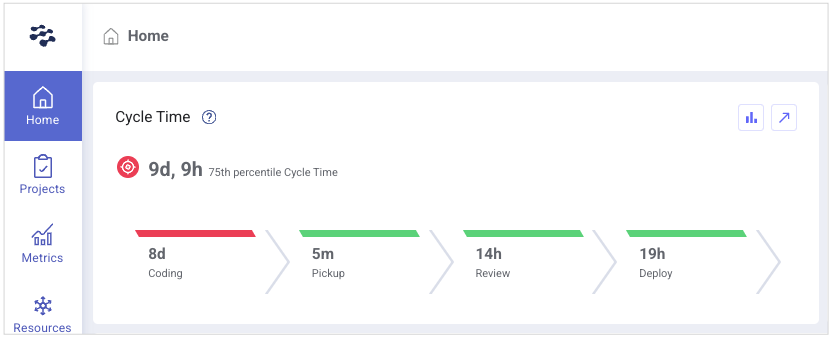Table of Contents
Reducing Change Failure Rate Through Smaller Deployments
Learn practical strategies for reducing Change Failure Rate by improving deployment practices, breaking work into smaller changes, and aligning coding workflows with DORA measurement principles.
The average coding time for a team is around 3-4 days, while elite teams maintain a coding time of approximately 1 day.

Identifying High Coding Time
- Team Level: In the Home dashboard, set your view to All Teams. If the coding time is high, the Cycle Time's Coding metric is displayed in red.

- Branch Level: In the Home dashboard, set your view to All Teams, and click the Cycle Time's Coding metric to identify branches with delays in coding time.


Causes of High Coding Time
- Undivided Tasks: Large pull requests (PRs) may indicate that issues aren't broken into manageable pieces. Collaborate with your team to divide assignments into smaller tasks.
- Unclear Project Requirements: Ambiguities can expand the scope of simple tasks. Consult with the product team to clarify and properly scope tasks.
- Complex or Hard-to-Read Code: Repositories with high rework and refactoring may be difficult to understand. Pairing experienced team members can help clean up and document complex code.
- Excessive Work in Progress (WIP): Multiple ongoing projects can lead to multitasking and frequent context switching, reducing efficiency. Use the Pulse view to review individual and team activities, and strive to balance workloads to minimize multitasking.

Strategies to Reduce Coding Time
Set Up Slack Alerts for High Risk Work
Configure Slack alerts to notify the team in real-time about large or heavily revised PRs. This helps identify tasks that need to be broken down.
- To create the Slack alert for your team, follow these steps:
- In the LinearB side menu, click Settings.
- In the Teams drop-down, select the team who you want to alert.
- Navigate to the Goals tab.
- Edit the High Risk Work goal.
- Set the alert threshold to your maximum amount of code changes per pull request, for example 100 code changes or 50 code changes.
- Define the Rework / Refractor size, for example above 50%.
- Click Save.
Once configured, your team's Slack channel will receive alerts about any high risk work. Team members can easily click the link in the notification to access the PR directly from Slack, ensuring faster reviews and streamlined workflows.


Build a Metrics Dashboard
Use LinearB’s Metrics tab to build a custom metrics dashboard monitoring Coding Time, PR Size, and Active Branches. This will allow you to monitor trends and identify potential bottlenecks in the review process.
Monitor for Large PRs and High Work in Progress
Regularly check the for large PRs and the Pulse View for team workloads. Managing PR size and balancing work assignments will help reduce coding time.
By implementing these strategies, your team can work towards reducing coding time and enhancing overall efficiency.
How did we do?
Mean Time to Restore (MTTR): Definition and Calculation
⭐️ Start here: Understanding and Configuring DORA Metrics